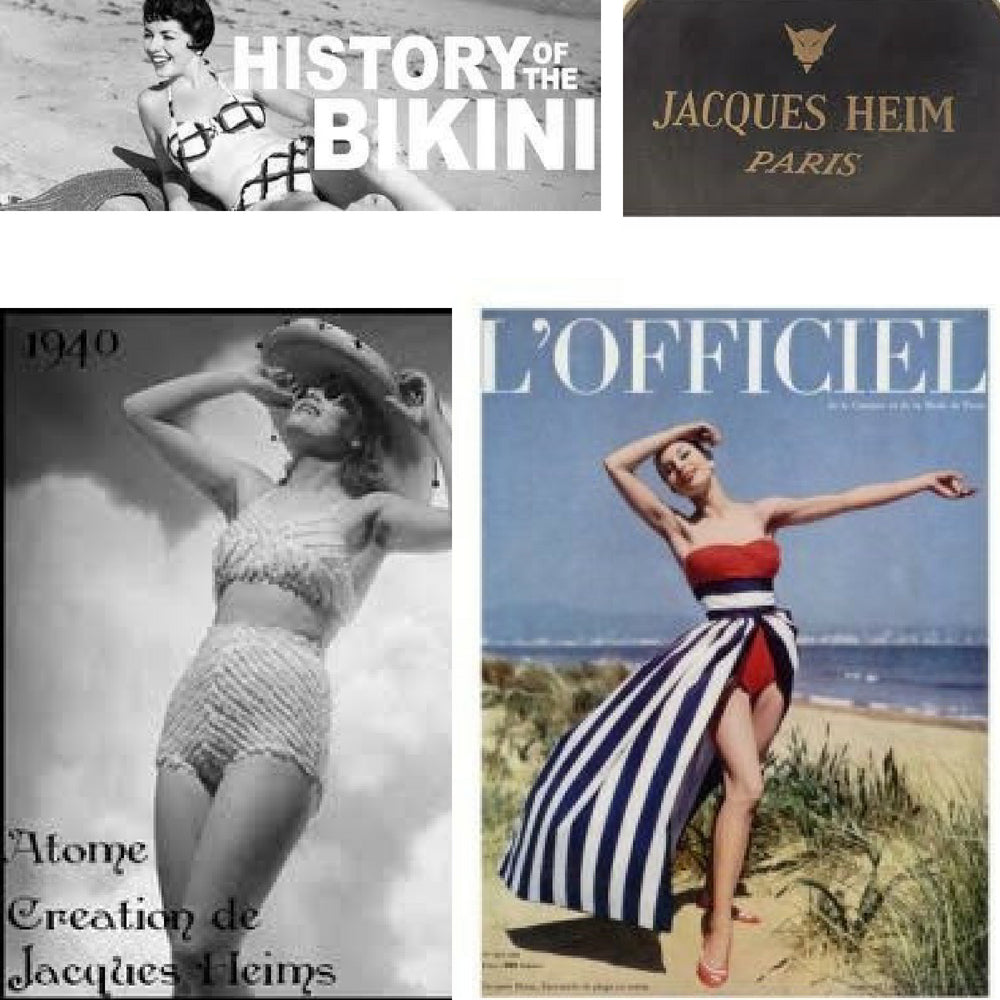🔥15% OFF- CODE GET 15 🔥
🔥15% OFF- CODE GET 15 🔥

What is the story of the Bikini?
July 04, 2020 5 min read 2 Comments
It is not entirely clear who the original inventor of the itty-bitty swimsuit was, with arguments for both Louis Reard, a Parisian-based mechanical engineer who took over his mother’s lingerie business in the 1940s, and Jacques Heim, a fashion designer, and owner of the Fashion House of Jacques Heim which was Avenue Matignon in Paris.
Both men developed two pieces swimsuits which exposed the naval, which for the time was a very dashing fashion choice, creating an explosion.
In 1932, Jacques Heim created a two-piece swimsuit consisting of a bra with ruffles and pretty bloomers, which he called the Atome. However, despite being available to the public in 1932, women were not yet ready to reveal their midriff, with only a few daring to wear his swimsuit.

In June 1946, he relaunched his two-piece swimsuit, the Atome, which he advertised as "the world's smallest bathing suit." However, on 5 July 1946, Louis Reard , a French engineer, had a Paris stripper pose before reporters in an even briefer two-piece swimsuit, which Réard called the Bikini and which he promoted as "smaller than the smallest bathing suit". Réard's design, unlike Heim's, for the first time presented a female swimsuit with the navel exposed. Though financially successful, the bikini was very controversial. The name Bikini for the swimsuit caught on and became the common name for the style of swimwear.
The iconic swimsuit became a revolution piece of fashion for women all over the world's beaches. Celebrities such as Brigitte Bardot and Marylin Monroe wore the two-piece adding to its popularity in the 60s; thanks to the two Parisian designers.

The bikini is typically a women's two-piece swimsuit. One part of the attire covers the breasts and the other part covers the crotch and part of or the entire buttocks, leaving an uncovered area between the two. Merriam–Webster describes the bikini as "a woman's scanty two-piece bathing suit" or "a man's brief swimsuit". It is often worn in hot weather while swimming or sunbathing. The shapes of both parts of a bikini resemble women's underwear, and the lower part can range from revealing thong or g-string to briefs.
The bikini is perhaps the most popular female beachwear around the globe, according to French fashion historian Olivier Saillard due to "the power of women, and not the power of
fashion". As he explains, "The emancipation of swimwear has always been linked to the emancipation of women." By the mid-2000s, bikinis had become an $811 million business annually, according to the NPD Group, a consumer and retail information company. The bikini has boosted spin-off services like bikini waxing and the sun tanning industries.
History
History of the bikini
Predecessors of the bikini date to antiquity, in Çatalhöyük and the Greco-Roman world. Art dating from the Diocletian period (286–305 AD) in Villa Romana del Casale, Sicily depicts women in garments resembling bikinis in mosaics on the floor. The images of ten women, dubbed the "Bikini Girls", exercising in clothing that would pass as bikinis today, are the most replicated mosaic among the 37 million colored tiles at the site. Archaeological finds, particularly in Pompeii, show the Roman goddess Venus wearing a bikini. A statue of Venus in a bikini was found in a cupboard in the southwest corner of Casa della Venere; others were found in the front hall. A statue of Venus was recovered from the tablinum of the House of Julia Felix, and another from an atrium at the garden at Via Dell'Abbondanza.
The groundwork for the modern bikini began to be laid in 1907 when Australian swimmer and performer Annette Kellerman was arrested on a Boston beach for wearing a form-fitting one-piece swimsuit, which became an accepted beach attire for women by 1910. In 1913, inspired by the introduction of women into Olympic swimming, designer Carl Jantzen made the first functional two-piece swimwear, a close-fitting one-piece with shorts on the bottom and short sleeves on top.
By the 1930s, necklines plunged at the back, sleeves disappeared and sides were cut away. Hollywood endorsed the new glamour with films such as Neptune's Daughter, in which Esther Williams wore provocatively named costumes such as "Double Entendre" and "Honey Child". With new materials like latex and nylon, by 1934 the swimsuit started hugging the body and had shoulder straps to lowered for tanning.
By the early 1940s, two-piece swimsuits were frequent on American beaches. Hollywood stars such as Ava Gardner, Rita Hayworth, and Lana Turner tried similar swimwear or beachwear. Pin-ups of Hayworth and Esther Williams in the costumes were widely distributed.
Finally, the modern bikini was introduced by fashion designer Jacques Heim and French engineer Louis Réard in Paris in 1946. Réard was a car engineer, but by 1946, he was running his mother's lingerie boutique near Les Folies Bergères in Paris.
Heim was working on a new kind of beach costume. It comprised two pieces, the bottom large enough to cover its wearer's navel. In May 1946, he advertised the bathing suit, known as the "Atome," as the world's "smallest bathing suit". Réard named his swimsuit the "bikini", taking the name from the Bikini Atoll, one of a series of islands in the South Pacific where testing on the new atomic bomb was occurring that summer.
Historians assume Reard termed his swimsuit the "bikini" because he believed its revealing style would create reactions among people similar to those created by America’s atomic bomb in Japan just one summer earlier. Réard sliced the top off the bottoms and advertised it as "smaller than the smallest swimsuit". Réard could not find a model to wear his design. He ended up hiring Micheline Bernardini, a nude dancer from the Casino de Paris. That bikini, a string bikini with a g-string back of 30 square inches (194 cm2) of cloth with newspaper-type printed across, was introduced on July 5 at Piscine Molitor, a public pool in Paris. Heim's design was the first worn on the beach, but clothing was given its name by Réard.
From a 1949 Los Angeles Times report: "The bathing beauty queen—blond Bebe Shopp, 18, of Hopkins, Minn.—got an enthusiastic welcome in Paris, but she said she hasn't changed her mind about French swimsuits. ... 'I don't approve of Bikini suits for American girls,' Bebe told her French interviewers. 'The French girls can wear them if they want to, but I still don't approve of them on American girls." Brigitte Bardot is recognised for popularising bikini swimwear in early films such as Manina (Woman without a Veil) (1952) in her appearances at Cannes, and in many photo shoots. Bardot was identified as the original Cannes bathing beauty.
PICTURES:
- Brigitte Bardot, French actress, wearing a Jacques Heim design
- Jacques Heim started the bikini and called his beach collection after the "Atol Bikini " a US nuclear experiment spot in the Pacific.
The Bikini was forbidden on the American Beaches, considered an outrageous scandalous!
2 Responses
Andrea Stein
July 16, 2020
I LOVE this store and everything in it.
If our Rand / Pound exchange wasnt so bad, I would buy many more things.
I absolutely love all I previously bought.
Keep up the stunning, sophisticated site and all your beautiful things.
xxxx
Leave a comment
Comments will be approved before showing up.


Alica
November 01, 2023
Great post and good point, This is really amazing and informative article, I really appreciate it
https://gogetdeals.co.uk/swimwear-deals